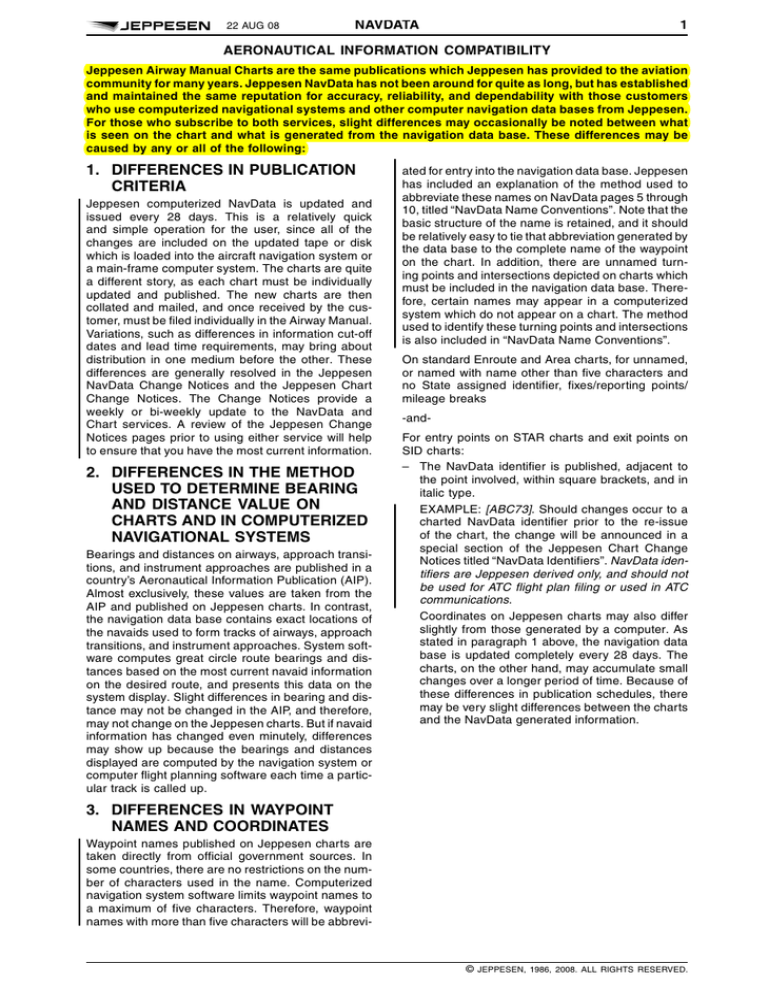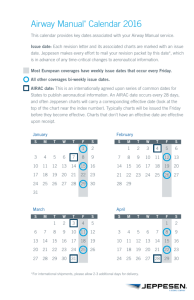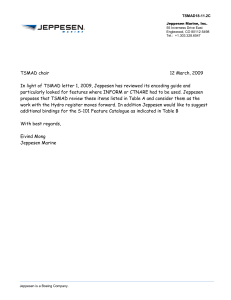
22 AUG 08
NAVDATA
1
AERONAUTICAL INFORMATION COMPATIBILITY
Jeppesen Airway Manual Charts are the same publications which Jeppesen has provided to the aviation
community for many years. Jeppesen NavData has not been around for quite as long, but has established
and maintained the same reputation for accuracy, reliability, and dependability with those customers
who use computerized navigational systems and other computer navigation data bases from Jeppesen.
For those who subscribe to both services, slight differences may occasionally be noted between what
is seen on the chart and what is generated from the navigation data base. These differences may be
caused by any or all of the following:
1. DIFFERENCES IN PUBLICATION
CRITERIA
Jeppesen computerized NavData is updated and
issued every 28 days. This is a relatively quick
and simple operation for the user, since all of the
changes are included on the updated tape or disk
which is loaded into the aircraft navigation system or
a main-frame computer system. The charts are quite
a different story, as each chart must be individually
updated and published. The new charts are then
collated and mailed, and once received by the customer, must be filed individually in the Airway Manual.
Variations, such as differences in information cut-off
dates and lead time requirements, may bring about
distribution in one medium before the other. These
differences are generally resolved in the Jeppesen
NavData Change Notices and the Jeppesen Chart
Change Notices. The Change Notices provide a
weekly or bi-weekly update to the NavData and
Chart services. A review of the Jeppesen Change
Notices pages prior to using either service will help
to ensure that you have the most current information.
2. DIFFERENCES IN THE METHOD
USED TO DETERMINE BEARING
AND DISTANCE VALUE ON
CHARTS AND IN COMPUTERIZED
NAVIGATIONAL SYSTEMS
Bearings and distances on airways, approach transitions, and instrument approaches are published in a
country’s Aeronautical Information Publication (AIP).
Almost exclusively, these values are taken from the
AIP and published on Jeppesen charts. In contrast,
the navigation data base contains exact locations of
the navaids used to form tracks of airways, approach
transitions, and instrument approaches. System software computes great circle route bearings and distances based on the most current navaid information
on the desired route, and presents this data on the
system display. Slight differences in bearing and distance may not be changed in the AIP, and therefore,
may not change on the Jeppesen charts. But if navaid
information has changed even minutely, differences
may show up because the bearings and distances
displayed are computed by the navigation system or
computer flight planning software each time a particular track is called up.
ated for entry into the navigation data base. Jeppesen
has included an explanation of the method used to
abbreviate these names on NavData pages 5 through
10, titled “NavData Name Conventions”. Note that the
basic structure of the name is retained, and it should
be relatively easy to tie that abbreviation generated by
the data base to the complete name of the waypoint
on the chart. In addition, there are unnamed turning points and intersections depicted on charts which
must be included in the navigation data base. Therefore, certain names may appear in a computerized
system which do not appear on a chart. The method
used to identify these turning points and intersections
is also included in “NavData Name Conventions”.
On standard Enroute and Area charts, for unnamed,
or named with name other than five characters and
no State assigned identifier, fixes/reporting points/
mileage breaks
-andFor entry points on STAR charts and exit points on
SID charts:
– The NavData identifier is published, adjacent to
the point involved, within square brackets, and in
italic type.
EXAMPLE: [ABC73]. Should changes occur to a
charted NavData identifier prior to the re-issue
of the chart, the change will be announced in a
special section of the Jeppesen Chart Change
Notices titled “NavData Identifiers”. NavData identifiers are Jeppesen derived only, and should not
be used for ATC flight plan filing or used in ATC
communications.
Coordinates on Jeppesen charts may also differ
slightly from those generated by a computer. As
stated in paragraph 1 above, the navigation data
base is updated completely every 28 days. The
charts, on the other hand, may accumulate small
changes over a longer period of time. Because of
these differences in publication schedules, there
may be very slight differences between the charts
and the NavData generated information.
3. DIFFERENCES IN WAYPOINT
NAMES AND COORDINATES
Waypoint names published on Jeppesen charts are
taken directly from official government sources. In
some countries, there are no restrictions on the number of characters used in the name. Computerized
navigation system software limits waypoint names to
a maximum of five characters. Therefore, waypoint
names with more than five characters will be abbreviq$z
© JEPPESEN, 1986, 2008. ALL RIGHTS RESERVED.



